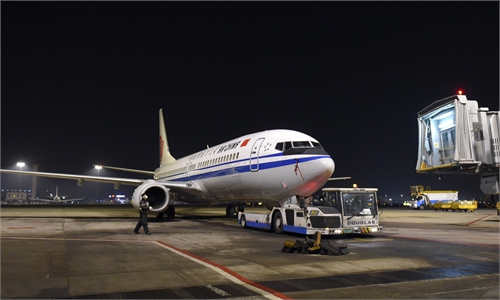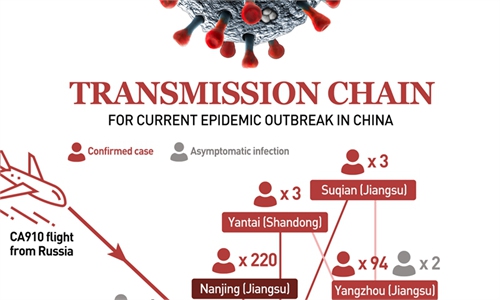
People watch a movie at the Capital Cinema (Xidan branch) in Beijing, capital of China, July 24, 2020. Part of cinemas in Beijing resumed operations on Friday with effective epidemic prevention measures in place. Photo: Xinhua
China had 153 medium- or high-risk COVID-19 areas as of 6 pm on Wednesday, the highest number since the nation's epidemic prevention and control situation was normalized after the outbreak in Wuhan was basically contained in April 2020, according to National Health Commission (NHC).
Seventeen provincial-level regions in China have seen confirmed cases or asymptomatic infections in the latest outbreak, said the NHC. On Wednesday, 71 local confirmed cases and 15 asymptomatic patients were reported in the Chinese mainland.
COVID-19 flare-ups in multiple places were found to be related to imported cases at local airports, ports and designated hospitals, and they have spread to a certain extent, said Mi Feng, a spokesperson of the NHC, at a Wednesday press conference held by the State Council and attended by officials of the transport, civil aviation and immigration authorities.
Scaled-up prevention and controls in the transportation network of the country will be imposed, according to the conference.
The National Immigration Administration said that ordinary entry and exit certificates will be suspended temporarily for non-essential and non-urgent cross-border movement in strengthened border control at ports.
Four circuit breakers had been imposed as of Tuesday, suspending operations of 18 shipping companies and suspending foreign crews on 438 ships from changing shifts at ports in China, said an official of the Ministry of Transport.
Transport operators engaged in imported cold-chain logistics are also banned from transporting imported food products that cannot provide the source of purchase. Workers dealing with cold-chain imports are required to undergo nucleic acid testing regularly.
Cross-city buses, taxies and ride-sharing services in cities with medium-high risk areas will be suspended.
Vaccination in the express delivery industry, which plays a pivot role in the daily life of Chinese people, will be prioritized in epidemic-hit areas, noted the State Post Bureau, adding that the vaccination rate in the industry exceeded 90 percent in the first half of 2021.
The latest outbreak, which started at an international airport in Nanjing, East China's Jiangsu Province on July 20, has continued to spread across the country, with the chain of transmission seeing an increase.
More than 400 cases have been reported nationwide. A total of 144 medium- or high-risk COVID-19 areas were designated as of 9 am on Wednesday, the highest number since the epidemic prevention and control situation was normalized, after the outbreak in Wuhan was basically contained in April 2020.
The country experienced several rounds of COVID-19 surges last year, but sporadically, and not on a large scale nationwide, officials said.
"This new round of outbreaks is the most complicated one among the recent outbreaks in China," Feng Zijian, a deputy director-general of the China Centers for Disease Control and secretary-general of the Chinese Preventive Medicine Association, was quoted as saying in a report of China Newsweek.
He said China is now faced with the challenge of the highly transmissible Delta mutant strain, which makes it more difficult to cope with this recent outbreak than the previous ones.
Experts at the national medical center for major public health events of Tongji Hospital of Huazhong University of Science and Technology in Wuhan, Central China's Hubei Province, told the Global Times that one feature of the recent outbreak is that the patients were all infected with the Delta variant and the disease progressed rapidly, taking an average of five days to reach the critical stage.
Feng noted that the public health measures taken by China to curb the spread of the virus are still effective, but some adjustments need to be made in the scope, duration and intensity of these measures, given actual conditions.



